7. Patterns of Communication
After many years of listening to interactions among people, I gradually became aware of certain seemingly universal patterns in the way people communicate. Over and over again I observed four ways people had of handling the negative results of stress. These four patterns——which I call placating, blaming, computing, and distracting——occurred when one was reacting to stress and at the same time felt one's self-esteem was diminished——that "the pot got hooked." In addition, the "hooked" one could not say so.
As I began to understand these patterns more fully, I saw that self-esteem became easily hooked when one had not developed a solid, appreciative sense of self-worth.When one is doubtful about one's worth, it is easy to use another's actions and reactions to define oneself. For instance, if someone called us green, we would agree without checking and take the other's comment as fitting us. We are green because the other person said so.
It's easy for anyone with doubts about self-worth to fall into this trap. I recommend you treat everything that comes to you from the outside as something with which to cope, not as a way to define yourself.
Likewise, stress alone need not feel like an attack on self-worth. Feeling stress might be painful or annoying, but that isn't the same as doubting your own worth.
Do you know your internal feeling when your pot gets hooked? When mine does, my stomach gets knots, my muscles get tight, I find myself holding my breath, and I sometimes feel dizzy. While all this is going on, I find that my thoughts concern the dialogue I am having with myself. The words are variations of “Who cares about me? I am unlovable. I can never do anything right. I am a nothing.” Descriptive words for this condition are embarrassed, anxious, incompetent, helpless, and fearful.
What I say at a point like this might be quite different from anything I am feeling or thinking. If I think that the only way out of my dilemma is to make things right with you——so you will think I am lovable, acceptable, and so on——I will say whatever I think would fit. It would not matter if it were true. What matters is my survival, and I have put that in your hands. When I do this, I give away my power.
Suppose, instead, I keep my survival and power in my hands. Then I can say straight out what I think and feel. I might feel some initial pain at exposing my weaknesses and taking any accompanying risk, but I avoid the greater pain of hurting myself physically, emotionally, intellectually, socially , and spiritually.
It’s important to understand that every time you talk, all of you talks. Whenever you say words, your face, voice, body, breathing, and muscles are talking, too:
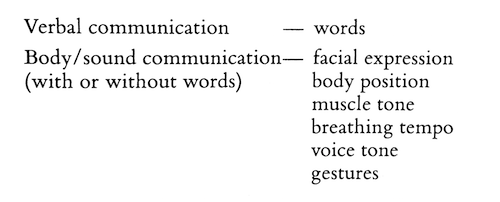
Discrepancies between verbal and nonverbal communication produce double messages. Your words are saying one thing, and the rest of you is saying something else. Have you ever heard, “Oh, I really like this!” and wondered why the speaker’s head was moving from side to side?
The troubled families I have known handled their communication through double messages. Double messages come through when a person holds the following views:
I have low self-esteem (low pot) and believe I am bad because I feel that way.
I am fearful about hurting the other person’s feelings.
I worry about retaliation from the other.
I fear rupture of our relationship.
I do not want to impose.
I am unconscious of anything but myself and do not attach any significance to the other person or the interaction itself.
In nearly all of these instances, the person is unaware of giving double messages.
So the listener will be confronted by two messages, and the outcome of the communication will be greatly influenced by her or his response. In general, the possibilities are: pick up the words and ignore the rest; pick up the nonverbal part and ignore the words; ignore the whole message by changing the subject, leaving, or going to sleep; or commenting on the double nature of the message.
For example, if I have a smile on my face and the words “I feel terrible” come out of my mouth, I am giving a double message. What are your options? Picking up on the above possibilities, you might respond to the words and say, “That’s too bad,” to which I can respond, “I was just kidding.” Your second choice is to respond to the smile and say, “You look great,” in which case I can say, “How can you say that!” Your third choice is to ignore the whole thing and go back to your paper, in which case I would respond, “What’s the matter? Don’t you give a damn?” Another choice, the leveling response, is to comment on my double message: “I don’t knows what you’re telling me. You’re smiling, yet you tell me you’re feeling bad. What gives?” I then have a chance to respond, “I didn’t want to impose on you,” and so on.

I believe that unless any family communication leads to realness or a straight, single meaning it cannot possibly lead to the trust and love necessary to nourish family members.
What goes on in a moment between two people has many more levels than are visible on the surface. The surface represents only a small portion of what is going on, much in the way that only a very small part of an iceberge is visible.
Thus, in this interaction:
“Where were you last night?”
“You are always nagging me!”
something is happening to each person in relation to herself or to himself.
Something is happening to the perception by each of the other.
The relationship can go toward distrust, personal low pot, or frustration. On the other hand, this can be the beginning of new depth and trust. Outcomes depend on the responses one chooses.
Let’s take a closer look at the four universal patterns people use to get around the threat of rejection. Feeling and reacting to the threat, the individual who doesn’t want to reveal weakness attempts to conceal it in the following ways:
Placate so the other person doesn’t get mad;
Blame so the other person will regard one as strong (if the person goes away, it will be her or his fault——not one’s own);
Compute so that one deals with the threat as though it were harmless, and one’s self-worth hides behind big words and intellectual concepts;
Distract so one ignores the threat, behaving as though it were not there (maybe if one does this long enough, it really will go away).
Our bodies have come to portray our feelings of self-worth whether we realize it or not. If our self-worth is in question, our bodies show it through some form of physical manifestation.
With this in mind I have devised certain physical stances to help people get in touch with parts of themselves that are obvious to other people but not always to themselves. I’ve exaggerated and expanded each facial and vocal message into the whole body so nobody can miss it.
To help clarify the responses (we will play out these roles in communication games in the next chapter), I have included a simple word-diagram with each descriptive section. Please note that these responses are used by men as well as women, by children as well as adults.
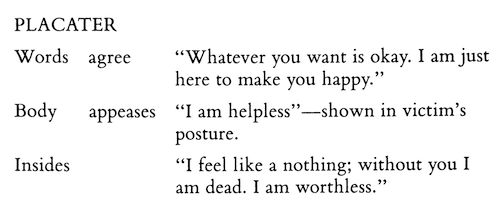
The placater talks in an ingratiating way, trying to please, apologizing, and never disagreeing, no matter what. This is a “yes man” who talks as though he could do nothing for himself; he must always get someone’s approval. You will find later that if you play this role for even five minutes, you feel nauseous and want to vomit.
A big help in doing a good placating job is to think of yourself as really worth nothing. You are lucky just to be allowed to eat. You owe everybody gratitude, and you really are responsible for everything that goes wrong. You know you could have stopped the rain if you used your brains, but you don’t have any. Naturally you will agree with any criticism of you. You are grateful that anyone even talks to you, no matter what they say or how they say it. You would not think of asking anything for yourself. After all, who are you to ask? Besides, if you can just be good enough, it will come by itself.
Be the most syrupy, martyrish, boot-licking person you can be. Think of yourself as being physically down on one knee, wobbling a bit, and putting out one hand in a begging fashion. Keep your head up so your neck will hurt, your eyes will strain, and in no time at all your head will ache.
When you talk in this position, your voice will be whiny and squeaky because you don’t have enough air to project a rich, full voice. You will be saying yes to every- thing, no matter what you feel or think. The placating stance is the body position that matches the placating response.

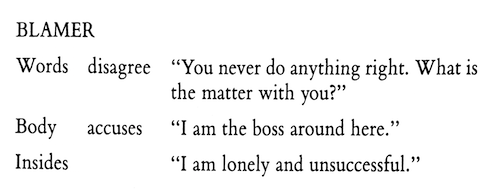
The blamer is a fault-finder, a dictator, a boss who acts superior and seems to be saying, “If it weren’t for you, everything would be all right.” The internal feeling is one of tightness in the muscles and organs. Meanwhile the blood pressure increases. The voice is hard, tight, and often shrill and loud.
Good blaming requires you to be as loud and tyrannical as you can. Cut down everything and everyone. Think of yourself pointing your finger accusingly and starting your sentence with “You never do this,” “You always do that,” “Why do you always,” “Why do you never,” and so on. Don’t bother about an answer; that is unimportant. The blamer is much more interested in throwing weight around than really finding out anything.
When you are blaming, you breathe in little tight spurts, or hold your breath altogether, keeping your throat muscles tight. Have you ever seen a really first-rate blamer whose eyes were bulging, neck muscles and nostrils standing out, skin getting red, and whose voice sounded like someone shoveling coal?
Think of yourself standing with one hand on your hip and the other arm extended with your index finger pointed straight out. Your face is screwed up, your lips curled, your nostrils flared as you yell, call names, and criticize everything under the sun. Your blaming stance looks like this:
You don’t really feel you are worth anything, either. So if you can get someone to obey you, then you feel you count for something. Given their obedient behavior, you feel effective.
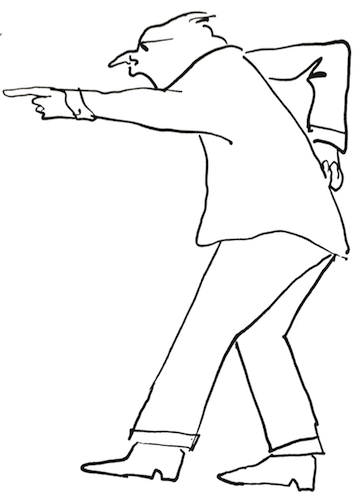
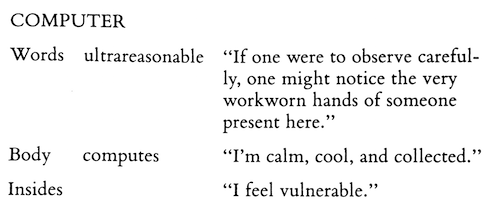
The computer is very correct, very reasonable, and shows no semblance of feeling. The person seems calm, cool, and collected. She or he could be compared to an actual computer or a dictionary. The body feels dry, often cool, and detached. The voice is a dry monotone, and the words are likely to be abstract.
When you are a computer, use the longest words possible, even if you aren’t sure of their meaning. You will at least sound intelligent. After one paragraph no one will be listening anyway. To get yourself really in the mood for this role, imagine that your spine is a long, heavy steel rod reaching from your buttocks to the nape of your neck, and a ten-inch-wide iron collar girds your neck. Keep yourself as motionless as possible, including your mouth. You will have to try hard to keep your hands from moving, but do it.
When you are computing, your voice will naturally go dead because you have no feeling from the cranium down. Your mind is bent on being careful not to move, and you are busy choosing the right words. After all, you should never make a mistake. The sad part of this role is that it seems to represent an ideal goal for many people. “Say the right words, show no feeling. Don’t react.”
Your computer position stance will look like this:
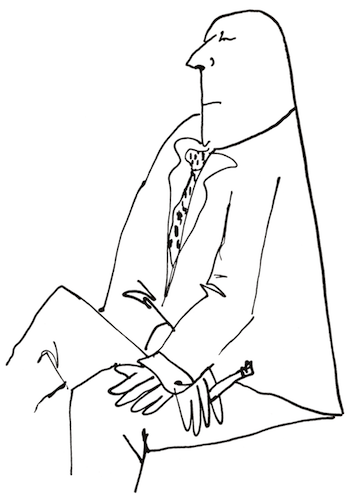
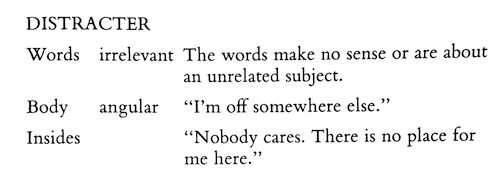
Whatever the distracter does or says is irrelevant to what anyone else is saying or doing. This person doesn’t respond to the point. The internal feeling is one of dizziness. The voice can be singsong, often out of tune with the words, and can go up and down without reason because it is focused nowhere.
When you play the distracting role, it will help you to think of yourself as a kind of lopsided top, constantly spinning but never knowing where you are going, and not realizing it when you get there. You are too busy moving your mouth, your body, your arms, your legs. Make sure you are never on the point with your words. Ignore everyone’s questions; maybe come back with one of your own on a different subject. Take a piece of imaginary lint off someone’s garment, untie people’s shoelaces, and so on.
Think of your body as going off in different directions at once. Put your knees together in an exaggerated knock- kneed fashion. This will bring your buttocks out, and make it easy for you to hunch your shoulders and have your arms and hands going in opposite directions.
At first this role seems like a relief, but after a few minutes of play, the terrible loneliness and purposelessness arise. If you can keep yourself moving fast enough, you won’t notice it so much.
You will look like this:
As practice for yourself, take the four physical stances I have described, hold them for just sixty seconds, and see what happens to you. Since many people are unaccustomed to feeling their body reactions, you may find at first that you are so busy thinking you aren’t

feeling. Keep at it, and you will begin to have the internal feelings you’ve experienced so many times before. Then, the moment you are on your own two feet and are freely relaxed and able to move, you find your internal feeling changes.
My hunch is that we learn these ways of communicating early in childhood. As children make their ways through the complicated and often threatening world in which they find themselves, they try out one or another of these communication patterns. After enough use the child can no longer distinguish response from feelings of worth.
Using any of these four responses bolsters an individual’s feeling of low self-worth or low pot. These ways of communicating are reinforced by the way we learn about authority in families and by attitudes prevalent in our society:
“Don’t impose; it’s selfish to ask for things for yourself” reinforces placating.
“Don’t let anyone put you down; don’t be a coward” reinforces blaming.
“Don’t be so stupid; you’re too smart to make mistakes” reinforces computing.
“Don’t be so serious. Live it up! Who cares?” reinforces distracting.
At this point you may well be wondering if these four crippling modes of communication are all we have. Of course not. There is another response that I have called leveling or flowing. In this response all parts of the message are going in the same direction: the voice’s words match the facial expression, body position, and voice tone. Relationships are easy, free, and honest, and people feel few threats to self-esteem. This response relieves any need to placate, blame, retreat into a computer, or be in perpetual motion.
Of the five responses, only leveling has any chance to heal ruptures, break impasses, or build bridges between people. And lest leveling seem too unrealistic to you, let me assure you that you can still placate if you choose, blame if you like, be on a head trip, or be distracting. The difference is you know what you are doing and are prepared to take the consequences.
When you are leveling, you apologize when you realize you’ve done something you didn’t intend. You are apologizing for an act rather than your existence. Likewise, you may criticize and evaluate in a leveling way, by evaluating an act, not blaming the person. Usually you’ll be able to offer a new direction as well.
At times, you’ll be talking about intellectual things, giving lectures, making explanations, or giving directions, when precise word meanings are essential. When you are leveling in this area, you are still showing your feelings and moving freely while you’re explaining. You aren’t coming off like a machine. (Many people who make their living with their brains——scientists, mathematicians, accountants, teachers, and therapists——are often motivated by a wish to be objective. They behave like machines and epitomize the computing response.) In addition, you will sometimes want to change the subject. In the leveling response you can say what you want to do instead of hopping all over the place.
The effect of leveling is congruence. When a leveler says, “I like you,” the voice is warm and the person looks at you. If the words are, “I am mad as hell at you,” the voice is harsh, and the face held tight. The message is single and straight.
The leveling response also represents a truth of the person at that moment. This is in contrast, for example, to a blaming response, in which the person is feeling helpless but is acting angry——or is hurting but is acting brave.
A third aspect of the leveling response is that it is whole, not partial. The body, thoughts, and feelings are all shown, in contrast to computing, for example, in which nothing moves but the mouth and that only slightly. People who are leveling show an integration, a flowing, an aliveness, an openness, and what I call a juiciness. Leveling makes it possible to live in a vibrant way, rather than a dead way. You trust these people; you know where you stand with them, and you feel good in their presence. Their position is one of wholeness and free movement.
Now, to help you distinguish these five different ways of expressing yourself, let me present five ways of apologizing. This can also serve as a demonstration before you play the games in the next chapter. Let's imagine that I have just bumped your arms.
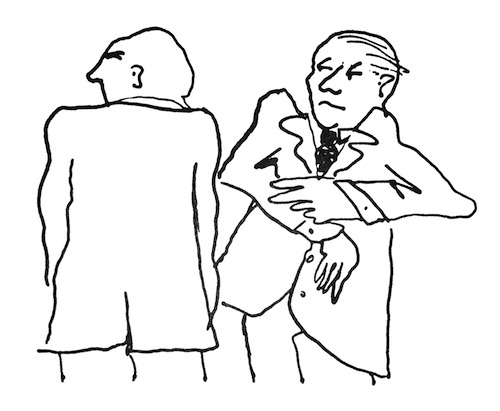
PLACATING (looking down, wringing hands): Please forgive me. I am just a clumsy oaf.
BLAMING: Ye gods, I just hit your arm! Keep it in next time so I won’t hit it!</p>
COMPUTING: I wish to render an apology. I inadvertently struck your arm in passing. If there are any damages, please contact my attorney.
DISTRACTING (looking at someone else): Gee, some guy’s mad. Must’ve got bumped.
LEVELING (looking directly at person): I bumped you. I’m sorry. Are you hurt?
Let’s take another imaginary situation. I am your father, and there is something wrong in what you, my son, are doing.
PLACATING (with a hushed voice, downcast face): I’m——uh, uh——gosh, gee, Jim, I . . . am sorry——you feeling okay? You know——promise me you won’t get mad. No, you’re doing okay, it’s just——maybe you could do a little better? just a little, maybe? Hm?
BLAMING: What’s the matter with you, don’t you know anything, you dumb cluck?
COMPUTING: We are making a survey of our family efficiency. We find that in this department, namely with you, efficiency is beginning to go down. Would you have any comments to make?
DISTRACTING (talking to his other son, standing next to Jim): Say, Arnold, is your room about the same as Jim’s? No, nothing wrong——I was just taking a walk through the house. Tell Jim to see his mother before he goes to bed.
LEVELING: Jim, your room is in bad shape. You haven’t made your bed since yesterday. We need to stop, take a look, and see what’s wrong.
It’s anything but easy to break old habit patterns and become a leveler. One way you might help yourself achieve this goal is to learn what some of your fears are that keep you from leveling. To thwart the rejection we so fear, we tend to threaten ourselves in the following ways:
I might make a mistake.
Someone might not like it.
Someone will criticize me.
I might impose.
She will think I am no good.
People might think me imperfect.
He might leave.
When you can tell yourself the following answers to the foregoing statements, you will have achieved real growth:
I am sure to make mistakes if I take any action, especially new action.
I can be quite sure that there will be someone who doesn’t like what I do. Not everyone likes the same things.
Yes, someone will criticize me. I really am not perfect. Some criticism is useful.
Sure! Every time I speak and interrupt in the presence of another person, I impose!
So maybe she will think I’m no good. Can I live through that? Maybe sometimes I’m not so hot. Sometimes the other person is “laying a trip on me.” Can I tell the difference?
If I think of myself as needing to be perfect, chances are I will always be able to find imperfection.
So he leaves. Maybe he should leave, and anyway, I’ll live through it.
These attitudes will give you a good opportunity to stand on your own two feet. It won’t be easy and it won’t be painless. If we can laugh at ourselves, the journey will be easier. You can grow and feel good about yourself. The outcome will be worth the effort.
With no intention of being flippant, I think most of the things we use to threaten ourselves and that affect our self-worth turn out to be tempests in teapots. This is an opportunity to see the joke in how we treat ourselves. Another way I helped myself through these threats was to ask myself if I would still be alive if all the imagined threats came true. If I could answer yes, then I was okay. I can answer yes to all of them now.
I will never forget the impact of discovering other people worried about these same silly threats. I had thought for years I was the only one, and I kept myself busy trying to outwit them, simultaneously doing my best to conceal my anxiety. My fear was, “What if somebody found out?” Well, what if somebody did? Now I know we all use these same kinds of things to threaten ourselves.
By now you realize this leveling response isn’t some kind of magical recipe. It’s a way of responding to real people in real situations that permits you to agree because you really do, not because you want to make points. Leveling allows you to use your brain freely but not at the expense of your feelings or your spirit. It also enables you to change course, not to get you off the book but because you want to and need to.
The leveling response makes it possible for you to live as a whole person: real, in touch with your head, your heart, your feelings, and your body. Being a leveler enables you to have integrity, commitment, honesty, intimacy, competence, creativity, and the ability to work with real problems in a real way. The four other communication patterns result in doubtful integrity, commitment by bargain, dishonesty, loneliness, shoddy performance, strangulation by tradition, and dealing in a destructive way with fantasy problems.
It takes guts, courage, some new beliefs, and some new skills to become a leveling responder. You can’t fake it.
People are hungry for straightness, honesty, and trust. When they become aware of it and are courageous enough to try it, they diminish their distance from other people.
I came to this awareness in a tough, trial-and-error way, trying to help people who had serious life problems. I found that people healed by finding their hearts, their feelings, their bodies, and their brains; this process once more brought them to their souls and thus their humanity. They could then express themselves as whole people, which in turn helped them to greater feelings of self-worth, nurturing relationships, and satisfying outcomes. None of these results is possible through the use of the four crippling ways of communication.
From what I have seen I’ve made some tentative conclusions about what to expect when I meet new groups of people. In general, 50 percent will say yes, no matter what they feel or think (placate); 30 percent will say no, no matter what they feel or think (blame); 15 percent will say neither yes nor no and will give no hint of their feelings

(compute); and 0.5 percent will behave as if yes, no, or any feeling did not exist (distract). That leaves only 4.5 percent who will be real, who will level. My colleagues tell me I am optimistic, saying the leveling response is probably found in only 1 percent of our population. (Again, this is not validated research. It is only a clinical hunch.)
In the vernacular, it would seem we are a bunch of emotional crooks, hiding ourselves, playing dangerous games with one another, and calling it society. If we want to make our bodies sick, become disconnected from other people, throw away our beautiful brainpower, and make our- selves mute, deaf, and blind, we can continue using only the four crippling ways of communication.
I feel very strongly as I write this. For me, isolation, helplessness, and feeling unloved, low-pot, or incompetent comprise the real human evils of this world. Certain kinds of communication perpetuate this, other kinds of communication can change it. If we can understand and recognize the leveling response, we can also learn to use it.
I would like to see each human being value and appreciate himself or herself, and feel whole, creative, competent, healthy, flexible, beautiful, and loving.
Despite my exaggerations of the first four ways of communication (they may even seem amusing) I am deadly serious about their killing nature. In the next chapter, when you play the games I have invented, you will experience exactly what these communication styles are like. You will quickly understand the toll they take on your body, the distrust that forms in your relationships, and the blah, disappointing, and many times disastrous outcomes that ensue.